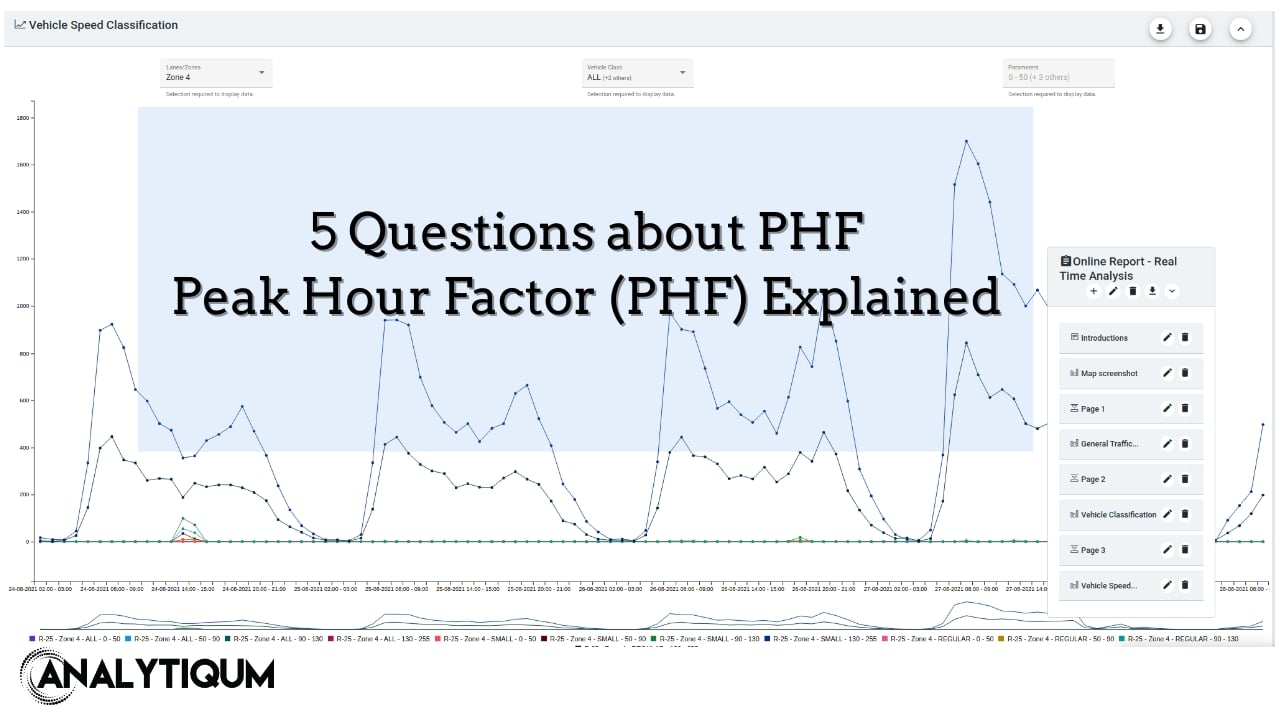5 Questions About Peak Hour Factor (PHF)
1. What is the Peak Hour Factor (PHF)?
The Peak Hour Flow (PHF) PHF is a number that measures how many cars are on the road at different times of the day. This number can help traffic planners figure out how to make the traffic flow better. Sometimes, making small changes to the way traffic moves can make a big difference in how smoothly it goes.
The Peak Hour Flow (PHF) is determined by dividing the number of vehicles that pass through a section of road during the peak hour by the number of vehicles that would pass in the 15 min peak volume within the peak hour, multiplied by 4.
The closer the PHF is to 1, the more constant traffic volume is during peak hours, and the closer it is to 0, the greater number of spikes there is.
The typical approach is to calculate it at least for the morning peak, middle day peak, and evening peak periods when traffic volumes are typically greater by hourly total traffic volume.
2. How is the peak hour factor PHF used to improve traffic conditions?
The peak hour factor (PHF) can be used in a number of ways to improve traffic conditions. By understanding how traffic flows at different times of the day, cities can make changes that will help reduce congestion and make it easier for people to get where they need to go.
3. What are some examples of how the PHF has been used to improve traffic conditions in other cities?
The peak hour factor (PHF) has been used in a number of cities to improve traffic conditions.
In Los Angeles, the peak hour factor (PHF) was used to help reduce traffic congestion during rush hour. By making some changes to the timing of traffic lights, the city was able to keep traffic moving more smoothly and reduce delays.
As a result, commuters wasted less time sitting in traffic and arrived at their destinations more quickly.
In New York City, the peak hour factor (PHF) was used to help improve the flow of traffic in Manhattan. By making changes to the way traffic signals were timed, the city was able to keep traffic moving more efficiently and reduce delays.
As a result, commuters saved time and arrived at their destinations more quickly.
The peak hour factor (PHF) has also been used in a number of other cities to improve traffic conditions.
In Boston, the peak hour factor (PHF) was used to help reduce traffic congestion during rush hour. By making some changes to the timing of traffic lights, the city was able to keep traffic moving more smoothly and reduce delays.
As a result, commuters wasted less time sitting in traffic and arrived at their destinations
4. What are the benefits of using the PHF to improve traffic conditions?
The peak hour factor (PHF) is a helpful tool that can be used to improve traffic conditions in a number of ways. By understanding how traffic flows at different times of the day, cities can make changes that will help reduce congestion and make it easier for people to get where they need to go.
In addition, the peak hour factor (PHF) can also be used to help plan new roads and public transit routes. By understanding how people travel, city planners can make sure that new infrastructure projects are designed in a way that will improve overall traffic flow and reduce congestion.
The peak hour factor (PHF) can also be used to inform pricing strategies for things like tolls and congestion pricing. By understanding how traffic patterns fluctuate throughout the day, city officials can set rates that will incentivize people to travel during less busy times. This can help to spread out traffic and reduce congestion during peak hours.
Ultimately, the peak hour factor (PHF) is a valuable tool that can be used to improve traffic conditions in a number of different ways. By understanding how traffic flows at different times of the day, cities can make changes that will help reduce congestion and make it easier for people to get where they need to go.
5. How can I learn more about the PHF?
If you are interested in learning more about the PHF or how it is used to improve traffic conditions, please check out the links below.
Highway Capacity Manual (HCM) Guide – The Peak Hour Factor (PHF) Explained
Federal Highway Administration (FHWA) – Traffic Data Computationmethod Pocket Guide
6. How to measure efficiently the traffic flow?
RTMS ECHO
The data collection can be done using the RTMS Echo sensors, which are really effective in collecting and storing the hourly hour volumes of a road section for up to 12 lanes.
The RTMS Echo radar is an IoT-ready radar that provides more actionable traffic information than any other.
The RTMS ECHO radar sensor technology provides useful and trustworthy data that maximize the efficiency of existing infrastructure while also enhancing safety and comfort in every neighborhood.
7. How to analyse efficiently the Peak Hour Factor?
AMP4SS
Our AMP4SS analytics platform is able to provide the peak hour factor (PHF) for the cities and support the analysis of how consistent traffic volume is and traffic engineers can also use it for other parameters like the capacity analysis.
The peak hour factor (PHF) is a helpful tool that can be used to improve traffic conditions in a number of ways. By understanding how traffic flows at different times of the day, cities can make changes that will help reduce congestion and make it easier for people to get where they need to go.
Thanks for reading! I hope this article was helpful in explaining what the PHF is and how it can be used to improve traffic conditions. If you have any questions or would like to learn more, please don’t hesitate to reach out and contact us.

